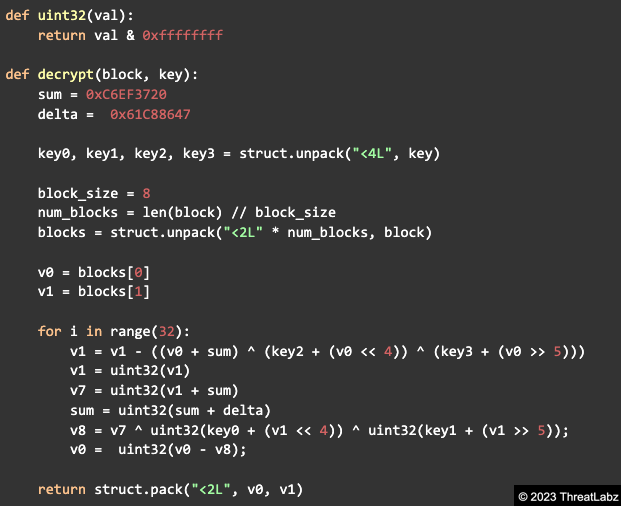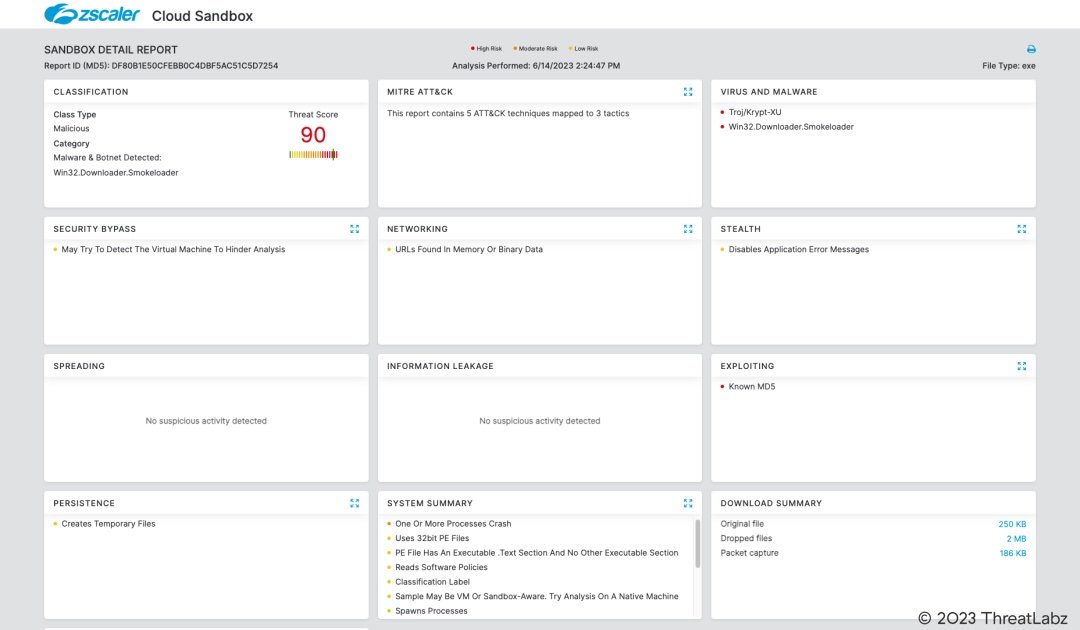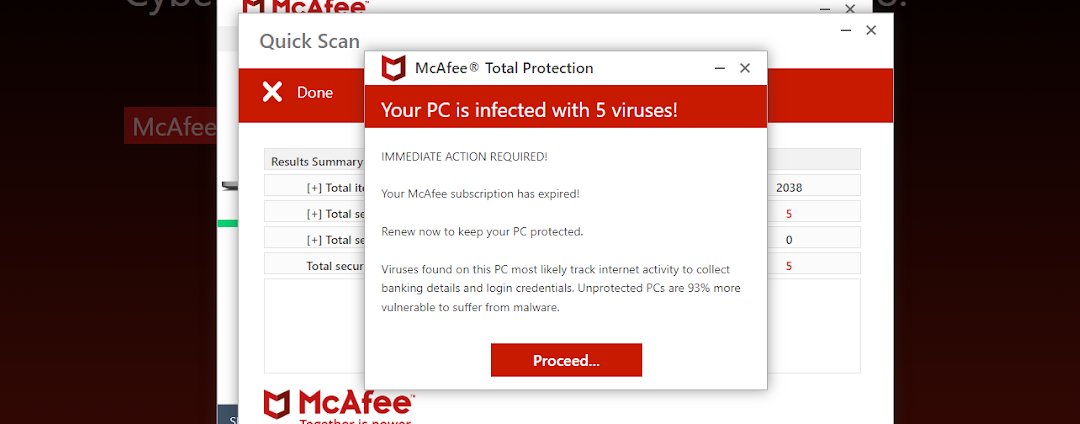Blog Zscaler
Recevez les dernières mises à jour du blog de Zscaler dans votre boîte de réception
Mystic Stealer
Key Points
- Mystic Stealer is a new information stealer that was first advertised in April 2023
- Mystic steals credentials from nearly 40 web browsers and more than 70 browser extensions
- The malware also targets cryptocurrency wallets, Steam, and Telegram
- The code is heavily obfuscated making use of polymorphic string obfuscation, hash-based import resolution, and runtime calculation of constants
- Mystic implements a custom binary protocol that is encrypted with RC4
How do you know when something is in hot demand in the underground economy? The same way you do in the real world – the market becomes flooded. This is the story of information stealers today. "Stealers" are a kind of malware designed to run on an endpoint post-compromise, while their primary features center on the theft of user data. Oftentimes this is credential data, but it can be any data that may have financial value to an adversary; this includes paid online service accounts, cryptocurrency wallets, instant messenger, or email contacts lists, etc. Stealers also bridge the realms of criminal and nation-state focus. Many espionage-focused threat groups operate stealer families for pilfering information from target networks. Credential information can further increase access or penetration into an environment. Demand for compromised credentials to fuel criminal access to user accounts and target networks has resulted in a steady stream of newly developed information-stealing malware, keeping account markets stocked. With the amount of visibility we have at Zscaler, we are accustomed to encountering new threats on a daily basis. Enter Mystic Stealer, a fresh stealer lurking in the cyber sphere, noted for its data theft capabilities, obfuscation, and an encrypted binary protocol to enable it to stay under the radar and evade defenses. Together with our colleagues at InQuest, we present a deep dive technical analysis of the malware. We also share indicators from an in-depth analysis of the infrastructure footprint of deployed Mystic Stealer controllers and countermeasures for detecting the client in your environment.
Note: the content of this blog is also hosted by InQuest here.
The Data Heist Specialist
Mystic Stealer focuses on data theft, exhibiting capabilities that allow it to pilfer a wide array of information. For starters, it is designed to collect computer information such as the system hostname, user name, and GUID. It also identifies a likely system user geolocation using the locale and keyboard layout. But it doesn't stop there.
Key Mystic Stealer functions include its ability to extract data from web browsers and cryptocurrency wallets. Like many stealers, it collects auto-fill data, browsing history, arbitrary files, cookies, and information related to cryptocurrency wallets. Whether it's Bitcoin, DashCore, Exodus, or any other popular crypto wallet, Mystic Stealer has it covered. Mystic can also steal Telegram and Steam credentials.
Interestingly, the stealer does not require the integration of third-party libraries for decrypting or decoding target credentials. Some leading stealer projects download DLL files post-install to implement functionality to extract credentials from files on the local system. Instead, Mystic Stealer collects and exfiltrates information from an infected system and then sends the data to the command & control (C2) server that handles parsing. This is a different approach from many leading stealers and is likely an alternate design to keep the size of the stealer binary smaller and the intention less clear to file analyzers.
The Mystic Stealer crimeware is implemented in C for the client and Python for the control panel.
Technical Analysis
Looking at the existing releases, it seems clear that the developer of Mystic Stealer is looking to produce a stealer on par with the current trends of the malware space while attempting to focus on anti-analysis and defense evasion.
In terms of capabilities, it's a fairly standard set of functionality as seen with many stealers today. The malware collects system information which is packaged together for a check-in to the C2 server:
- Keyboard layout
- Locale
- CPU information
- Number of CPU processors
- Screen dimensions
- Computer name
- Username
- Running processes
- System architecture
- Operating system version
Key data theft functionality includes the ability to capture history and auto-fill data, bookmarks, cookies, and stored credentials from nearly 40 different web browsers. In addition, it collects Steam and Telegram credentials as well as data related to installed cryptocurrency wallets. The malware targets more than 70 web browser extensions for cryptocurrency theft and uses the same functionality to target two-factor authentication (2FA) applications. The approach used by Mystic Stealer is similar to what was reported for Arkei Stealer. Further details on targeted browsers, cryptocurrency plugins, and 2FA apps are available in the appendix.
Depending on a configuration provided by the C2 server, the malware will capture a screenshot of the desktop, which is exfiltrated to the C2 server.
On May 20, the Mystic Stealer seller posted updates that include loader functionality and a persistence capability to forums as shown in Figure 1. Loader refers to the ability to download and execute additional malware payloads. This is reflective of a continuing trend where loaders allow one threat actor to support the distribution of affiliate malware being loaded on compromised devices. This is already a notable risk for many organizations due to the use of malware distribution networks and initial access brokers for the distribution of high-severity payloads like ransomware. It underscores the need to take preventative steps to ensure a security posture that reduces the risk of malware delivery and footholds early on in attack campaigns.

Figure 1. MysticStealer forum post advertising v1.2 update with loader support
As previously noted, there are several anti-analysis and evasion features additionally present in Mystic Stealer:
Binary expiration. The trojan will terminate execution if the running build is older than a specified date. This is likely an execution guardrail that attempts to prevent anti-malware researchers and sandboxes that analyze the sample much later than when it was intended to be distributed or executed on victim machines. Figure 2 shows a Mystic Stealer sample that retrieves the current system time and compares the value to 1685318914 (0x6473ED02), which when converted from an epoch to a timestamp translates to Sun May 28 17:08:34 2023.

Figure 2. Example Mystic Stealer date expiration feature
Anti-virtualization. Mystic Stealer is configurable and some samples contain anti-VM features, detecting hypervisor runtime environments, and avoiding execution. This is helpful for avoiding execution in sandbox environments but it isn't always effective.
Mystic uses the CPUID assembly instruction to detect virtual environments by inspecting the result for specific values that are indicative of virtualization software. In particular, the code checks for the manufacturer ID string (with a length of 12 bytes) for the following values:
- “XenVMMXenVMM” (Xen HVM)
- “VMwareVMware” (VMware)
- “Microsoft Hv” (Microsoft Hyper-V)
- “ KVMKVMKVM “ (KVM)
- “prl hyperv “ (Parallels)
- “VBoxVBoxVBox” (VirtualBox)
This detection code is likely derived from Pafish.
Windows APIs imported by hash. The stealer resolves and dynamically loads Windows APIs using a custom XOR based hashing algorithm represented in the Python snippet shown below:

Note that the constant value (e.g., 0x240CE91) changes between Mystic samples. The malware walks the export tables for the following Windows DLLs and hashes each export name until a match is found:
- Kernel32.dll
- Advapi32.dll
- Kernel32.dll
- Gdiplus.dll
- Crypt32.dll
- User32.dll
- Ws2_32.dll
- Ole32.dll
- Gdi32.dll
- Ntdll.dll
Dynamic constant calculation. Constant values in the code are obfuscated and dynamically calculated at runtime. For example, the API hashing algorithm shown above uses the constant 0x240CE91. However, this constant does not directly exist in the code. Instead, the value 0x240CEA6 is present and the code performs an XOR operation with the value 0x37 to produce the actual constant 0x240CE91 as shown in Figure 3.

Figure 3. Example Mystic Stealer constant obfuscation technique
Encrypted binary custom protocol. The client communicates with the C2 server using a custom protocol over TCP, which we discuss in more depth later.
Polymorphic string obfuscation. We identified that the malware obfuscates strings using a library that is very similar to ADVobfuscator. The obfuscator generates code at compile time that builds strings on the stack, which are then decrypted at runtime. The obfuscation is polymorphic, and therefore, every sample will contain strings that are uniquely encrypted with simple mathematical operations such as addition, subtraction, and XOR. As a result, this technique may bypass static antivirus signatures and complicate malware reverse engineering.
The Mystic Stealer seller refers to this obfuscation as a morpher that obfuscates builds with full undetectability (FUD) in sales threads. In one forum, the seller advertised that the project's morpher enabled the bypass of SmartScreen, which members identified as a dubious claim based on the operation of obfuscators and SmartScreen. Some forum users suspected the use of an open-source obfuscator. This ended up as a point of contention in the forum, lowering the perception and trust of the project with some users.
C2 Communication
Mystic Stealer communicates with its command and control (C2) servers using a custom binary protocol over TCP.
- The client sends a hello message containing a constant 4 byte value (0x946F19B5) to the C2 server.
- The C2 responds with 256 bytes of binary data that is used as an RC4 key for all subsequent communications.
- The client obtains the machine GUID from the registry value SOFTWARE\Microsoft\Cryptography\MachineGuid.
- The client encrypts the GUID value (along with this GUID length) using RC4 and sends it to the C2 server.
- The format of packets received from the server consists of a 4 byte big endian data size value followed by the data buffer. All data is encrypted with RC4.
- The C2 server responds back with a binary configuration of the actions to perform (steal credentials, take screenshots, steal cryptocurrency wallets, etc). This configuration is structured by 1’s and 0’s representing whether to enable or disable a feature, respectively.
- Data stolen from the infected system is labeled with specific binary tags that identify the type of information when it is sent to the C2 server.
- Unlike most stealers that will harvest data in full and then exfiltrate it to a C2 server with a single request, Mystic Stealer will collect various types of information and immediately send the data to a C2 server on-the-fly without storing or writing data to the disk, which may be detected by EDR/antivirus applications.
The builder enables operators to specify up to four C2 endpoints. This is often used in crimeware to provide resiliency in case some servers are offline or blocklisted. In Mystic Stealer binaries, there are two arrays consisting of 4 DWORDs each that are encrypted with a modified XTEA-based algorithm. Thus, each sample can configure up to 4 IP addresses and ports. A Python-based implementation of the decryption algorithm for Mystic C2s is shown below:

A few generations of the C2 servers seem to utilize a default port of 16287/tcp as seen in Figure 4 of the control panel builder dialog posted in a sales thread on underground forums. We have not observed file samples where this port was utilized for the configured C2 servers. The following C2 ports have been observed in identified samples, providing some clustering by build configurations:
- 15555/tcp
- 15556/tcp
- 13219/tcp

Figure 4. Mystic Stealer control panel builder dialog
C2 server footprint
The stealer has been linked to multiple server-hosting IP addresses across a diverse geographic spectrum, including but not limited to registrations in France, Germany, Russia, the United States, and China. We list C2 servers identified by the hosting panel and C2 callbacks in the appendix. Large commercial hosting provider Hetzner (AS24940) accounts for nearly half of the hosts in addition to a number at OVH (AS16276). However, we also note a number of servers within the Latvian, Bulgarian and Russian hosting spheres. These include:
- Aeza Group Ltd (AS210644)
- GIR-AS (AS207713)
- Partner-AS / LetHost LLC (AS204603)
- Scalaxy B.V. (AS58061)
- Sukhoi Su-57 LLC (AS46308)
- WAICORE-TRANSIT (AS202973)
Some of these providers stand out as potential contenders in the realm of bulletproof hosting, a term that sets off alarm bells in the cybersecurity world. Bulletproof hosting providers are entities that offer services with a particular appeal to individuals and groups engaged in nefarious activities, due to the providers' lax enforcement of legal norms and frequent protection and misdirection efforts that they take on behalf of criminal clientele. These services are often used to host malware, command and control servers, phishing campaigns, and other illicit digital operations. InQuest and Zscaler note a particular tendency of operators of credential stealers and other malware as a service (MaaS) systems to utilize protected backend hosting in the underground services space. This strategy often affords greater capabilities in blocklist avoidance as well as the reduced impact of takedown efforts and law enforcement reach.
The "Grand" cluster
One particular cluster of C2 servers sticks out when searching for hosted control panels. We have labeled this the "Grand" cluster based on WHOIS artifacts seen with some domains. We have included a list of these domains in the appendix. This group of domains is noted to share the following attributes:
- Cloudflare nameservers and CDN fronting
- Nameservers: meadow, jimmy
- Registration details:
- Domains registered mid-late 2022
- Registrar: Public Domain Registry (PDR Ltd.)
- Registrant State/Province: Novosibirskaya oblast
- Registrant Country: RU
- Registrant: Grand (grand.bbs[@]yandex.ru)
We note that while the majority of domains follow the above registration convention, a few outliers exist. For example, the domain alchemistwallet[.]io is registered with NetEarth One Inc., and one or more domains use different authoritative nameserver pairs (amit, jacqueline; rosalyn, stan). One or more domains were additionally registered in 2023.
Several of these domains were mentioned in a note by FalconFeedsio. We believe that these domains were likely picked up from domain aftermarket resale, a tactic that can yield tangible value for an adversary. Already-registered domains carry established reputation attributes based on past usage, and we note that some of these domains carry reputation scores in various datasets indicating that they had relatively high rankings. For example, looking at gujaratstudy[.]in, we can see that the domain was most recently registered on 2022-10-07. Prior to this date, in 2021, the domain was registered and hosted by a previous owner, with DNS resolution observed through October of 2021. After the new DNS registration by the Grand persona, the domain was initially live via authoritative DNS in regway.com on 2023-10-08, and then migrated to Cloudflare DNS on 2023-10-11. This pattern is fairly consistent through domains in the Grand cluster. Another domain, bhandarapolice[.]org, appears to have previously been used for the official website of an Indian district police department. The domain's category labels on VirusTotal still reflect a positive reputation: government, public information, top-1M. A WHOIS record showing the registration details of a representative domain from this set is available in the appendix.
The following domains and registration dates are samples of some domains found in this cluster:
- HANOIGARDEN[.]NET (2022-07-19)
- BHANDARAPOLICE[.]ORG (2022-07-20)
- ENGTECHJOURNAL[.]ORG (2022-07-20)
- MARISOLBLOOMS[.]COM (2022-07-20)
- WORDCZARMEDIA[.]COM (2022-08-07)
- COLORADOTRUCKIE[.]COM (2022-08-14)
- BABYPICTURESULTRASOUND[.]COM (2022-09-08)
- SACREDSPACE-SF[.]COM (2022-09-08)
- TEAMMSOLUTIONS[.]COM (2022-09-08)
- AFRICAHELP[.]ORG (2022-09-13)
- BAYSWATERHOLDING[.]COM (2022-09-20)
- ASHRAYAKRUTIFOUNDATION[.]ORG (2022-10-07)
- GUJARATSTUDY[.]IN (2022-10-07)
The nature of the Grand cluster is not completely known at this time. Until recently, the domains have been live and serving Mystic Stealer control panels as shown in Figure 5 below.

Figure 5. Example Mystic Stealer control panel domains cached in Google Search cache related to the Grand cluster
While possible that they are simply C2 servers, we did not identify file samples associated with them. Recently, many of the sites appear to have gone offline with the upstream CDN reporting connection failures. It may be possible that the domains are part of a traffic distribution or frontend proxy and traffic service.
Control Panel
The Mystic Stealer developers provide a web-based admin control panel as shown in Figure 6.

Figure 6. Mystic Stealer web admin control panel login page
Crimeware control panels allow operators to configure settings and access data collected from deployed malware and typically serve as the interface for criminal users to interact with the software. Common functions include statistics dashboards, malware builders, controlling options and features, credential log and data access, integration configurations, and more. The Mystic Stealer control panel operates out of band on a separate exposed service port than the malware utilizes for C2 communications. The developers utilize the Python Django web framework for the control panel. While not exclusive, the use of Python frameworks in crimeware development, typically dominated by PHP applications, is somewhat rare. As a historical example, another crimeware project implemented on Django was the Nice Pack exploit kit.
The control panel is deployed on a customer's server. The commonly observed service port for deployed panels is 443/tcp. An earlier observed deployment in March 2023 utilized 8005/tcp.
A number of community members have shared information identifying IP addresses of hosting panels. A number of these are also identified and archived on urlscan.io:
2023-03-22 https://urlscan.io/result/535841c6-ea4a-4e8c-85b7-e19bd5ad68e5
- Control panel - hXXp://164.132.200[.]171:8005/login/
2023-03-22 https://urlscan.io/result/7b2e16cb-9b66-4192-8b69-98fb89fa12ea/
- Control panel - hXXp://164.132.200[.]171:8005/login/
2023-05-02 https://urlscan.io/result/3fdaf5e7-a741-4cb8-8fa9-dedb00b1672b
- Control panel - hXXp://135.181.47[.]95/login/
2023-05-02 https://urlscan.io/result/5d326ed9-3bcc-40f3-9fd2-2bdea6fd800f
- Control panel - hXXp://95.216.32[.]74/login/
2023-05-04 https://urlscan.io/result/882d8d05-1523-41eb-892f-ba58d6656512/
- Control panel - hXXp://185.252.179[.]18/
2023-05-04 https://urlscan.io/result/cc6be796-ee37-4cc4-a37f-c9abb9bf17bc/
- Django admin control panel - hXXp://185.252.179[.]18/admin/
2023-05-15 https://urlscan.io/result/16f972cb-adb8-486a-9bff-3bebb673792e/
- Control panel - hXXp://212.113.106[.]114/login/
2023-05-25 https://urlscan.io/result/b5224ba6-1b50-42b0-b453-46204ebd1358/
- Django admin control panel - hXXp://www.coloradotruckie[.]com/admin/
2023-06-05 https://urlscan.io/result/016de1c6-cb24-4e3a-9ffa-5f8c21edf2c5/
- Control panel - hXXp://213.142.147[.]235/login/
Tracking an installation of a control panel for the month of May, we've seen the version of the deployed panel change, likely reflecting upgrades by the customer:
- 2023-05-03: Mystic Stealer - Login
- 2023-05-08: Mystic Stealer v1.1 - Login
- 2023-05-31: Mystic Stealer v1.2 - Login
We also note that the utilized page style is not exclusive to Mystic Stealer, appearing to be borrowed from or relating to a more broadly accessible template seen with other applications. The control panel UI kit appears to be based on Datta Able for Django. We do not believe there is any connection between this project and Mystic Stealer. It is likely that the Mystic Stealer developer is simply using the publicly available open-source UI kit.
Presence on Underground Forums
Mystic Stealer made its public debut on underground forums in late April 2023, several weeks after initial samples were known to surface. A seller named Mystic Stealer joined the WWH (WWH-Club) and BHF (Best Hack Forums, using the name MysticStealer) forums just a couple of days before posting, and, the stealer was listed for rent at a price of $150 per month. The seller later advertised Mystic Stealer on the XSS forum. Information-stealing trojans are a hot commodity in the underground economy, underscoring the level of emphasis the criminal community places on the collection of credentials to drive initial access into target user accounts and network environments. With its comprehensive data collection capabilities, it's no surprise that Mystic Stealer has caught the attention of members of these forums. According to observed advertisements, this seller also operates a Telegram account named @mysticstealer and the channel t[.]me/+ZjiasReCKmo2N2Rk (Mystic Stealer News).
Conclusion
As Mystic Stealer is a new player, it's hard to predict its trajectory. What's clear, however, is that it's a sophisticated threat with the potential for widespread damage. Over the past few weeks, we've observed a fascinating dance of panels appearing and disappearing. Yet, amidst this volatility, a number of these elusive entities have maintained their persistent presence. These patterns could be attributed to a range of factors: perhaps a surge in fresh sales, the relentless pursuit of takedowns, or the unpredictable behavior of the customers themselves.
This was a joint research collaboration between Zscaler ThreatLabz and InQuest. Special thanks to all of those involved from InQuest Labs.
Cloud Sandbox

In addition to sandbox detections, Zscaler’s multilayered cloud security platform detects indicators related to Mystic Stealer at various levels with the following threat names:
Appendix
C2 server endpoints observed in recent bot configurations
- 194.169.175[.]123:13219
- 185.252.179[.]18:13219
- 142.132.201[.]228:13219
- 135.181.47[.]95:13219
- 94.130.164[.]47:13219
- 94.23.26[.]20:13219
- 91.121.118[.]80:13219
Targeted web browsers
- Opera
- K-Meleon
- Mozilla icecat
- Mozilla Firefox
- Comodo IceDragon
- 8pecxstudios Cyberfox
- NETGATE Technologies BlackHawk
- Torch
- Chedot
- Kometa
- liebao
- Comodo
- Iridium
- Vivaldi
- Orbitum
- K-Melon
- Chromium
- QIP Surf
- Maxthon3
- Nichrome
- Chromodo
- Amigo
- 7Star
- CentBrowser
- Mail.Ru Atom
- Google Chrome
- Coowon
- uCozMedia Uran
- CocCoc Browser
- Microsoft Edge
- Sputnik
- Elements Browser
- 360Browser
- Epic Privacy Browser
- CatalinaGroup Citrio
- YandexBrowser
- MapleStudio ChromePlus
- Brave-Browser
- Fenrir Inc Sleipnir5 ChromiumViewer
Targeted MFA and cryptocurrency wallet browser extensions
| Extension ID | Browser Extension Name |
| Ibnejdfjmmkpcnlpebklmnkoeoihofec | TronLink |
| fhbohimaelbohpjbbldcngcnapndodjp | BinanceChain |
| ffnbelfdoeiohenkjibnmadjiehjhajb | Yoroi |
| jbdaocneiiinmjbjlgalhcelgbejmnid | Nifty Wallet |
| afbcbjpbpfadlkmhmclhkeeodmamcflc | Math Wallet |
| hnfanknocfeofbddgcijnmhnfnkdnaad | Coinbase Wallet |
| hpglfhgfnhbgpjdenjgmdgoeiappafln | Guarda |
| blnieiiffboillknjnepogjhkgnoapac | EQUAL Wallet |
| cjelfplplebdjjenllpjcblmjkfcffne | Jaxx Liberty |
| fihkakfobkmkjojpchpfgcmhfjnmnfpi | BitApp Wallet |
| kncchdigobghenbbaddojjnnaogfppfj | iWallet |
| amkmjjmmflddogmhpjloimipbofnfjih | Wombat |
| nlbmnnijcnlegkjjpcfjclmcfggfefdm | MEW CX |
| nanjmdknhkinifnkgdcggcfnhdaammmj | GuildWallet |
| nkddgncdjgjfcddamfgcmfnlhccnimig | Saturn Wallet |
| fnjhmkhhmkbjkkabndcnnogagogbneec | Ronin Wallet |
| cphhlgmgameodnhkjdmkpanlelnlohao | NeoLine |
| nhnkbkgjikgcigadomkphalanndcapjk | Clover Wallet |
| kpfopkelmapcoipemfendmdcghnegimn | Liquality Wallet |
| aiifbnbfobpmeekipheeijimdpnlpgpp | Terra Station |
| dmkamcknogkgcdfhhbddcghachkejeap | Keplr |
| fhmfendgdocmcbmfikdcogofphimnkno | Sollet |
| cnmamaachppnkjgnildpdmkaakejnhae | Auro Wallet |
| jojhfeoedkpkglbfimdfabpdfjaoolaf | Polymesh Wallet |
| flpiciilemghbmfalicajoolhkkenfel | ICONex |
| nknhiehlklippafakaeklbeglecifhad | Nabox Wallet |
| hcflpincpppdclinealmandijcmnkbgn | KHC |
| ookjlbkiijinhpmnjffcofjonbfbgaoc | Temple |
| mnfifefkajgofkcjkemidiaecocnkjeh | TezBox |
| lodccjjbdhfakaekdiahmedfbieldgik | DAppPlay |
| Ijmpgkjfkbfhoebgogflfebnmejmfbml | BitClip |
| lkcjlnjfpbikmcmbachjpdbijejflpcm | Steem Keychain |
| nkbihfbeogaeaoehlefnkodbefgpgknn | MetaMask |
| bcopgchhojmggmffilplmbdicgaihlkp | Hycon Lite Client |
| klnaejjgbibmhlephnhpmaofohgkpgkd | ZilPay |
| aeachknmefphepccionboohckonoeemg | Coin98 Wallet |
| bhghoamapcdpbohphigoooaddinpkbai | Authenticator |
| dkdedlpgdmmkkfjabffeganieamfklkm | Cyano Wallet |
| nlgbhdfgdhgbiamfdfmbikcdghidoadd | Byone |
| onofpnbbkehpmmoabgpcpmigafmmnjhl | Nash Extension |
| cihmoadaighcejopammfbmddcmdekcje | Leaf Wallet |
| gaedmjdfmmahhbjefcbgaolhhanlaolb | Authy 2FA |
| oeljdldpnmdbchonielidgobddffflal | EOS Authenticator |
| ilgcnhelpchnceeipipijaljkblbcobl | GAuth Authenticator |
| imloifkgjagghnncjkhggdhalmcnfklk | Trezor Password Manager |
| infeboajgfhgbjpjbeppbkgnabfdkdaf | OneKey |
| cgeeodpfagjceefieflmdfphplkenlfk | EVER Wallet |
| pdadjkfkgcafgbceimcpbkalnfnepbnk | KardiaChain Wallet |
| acmacodkjbdgmoleebolmdjonilkdbch | Rabby Wallet |
| bfnaelmomeimhlpmgjnjophhpkkoljpa | Phantom |
| fhilaheimglignddkjgofkcbgekhenbh | Oxygen - Atomic Crypto Wallet |
| mgffkfbidihjpoaomajlbgchddlicgpn | Pali Wallet |
| hmeobnfnfcmdkdcmlblgagmfpfboieaf | XDEFI Wallet |
| lpfcbjknijpeeillifnkikgncikgfhdo | Nami |
| dngmlblcodfobpdpecaadgfbcggfjfnm | MultiversX DeFi Wallet |
| bhhhlbepdkbapadjdnnojkbgioiodbic | Solflare Wallet |
| jnkelfanjkeadonecabehalmbgpfodjm | Goby |
| jhgnbkkipaallpehbohjmkbjofjdmeid | SteemKeychain |
| jnlgamecbpmbajjfhmmmlhejkemejdma | Braavos Smart Wallet |
| kkpllkodjeloidieedojogacfhpaihoh | Enkrypt: Ethereum, Polkadot & RSK Wallet |
| mcohilncbfahbmgdjkbpemcciiolgcge | OKX Wallet |
| gjagmgiddbbciopjhllkdnddhcglnemk | Hashpack |
| kmhcihpebfmpgmihbkipmjlmmioameka | Eternl |
| phkbamefinggmakgklpkljjmgibohnba | Pontem Aptos Wallet |
| lpilbniiabackdjcionkobglmddfbcjo | Keeper Wallet |
| cjmkndjhnagcfbpiemnkdpomccnjblmj | Finnie |
| aijcbedoijmgnlmjeegjaglmepbmpkpi | Leap Terra Wallet |
| fdjamakpfbbddfjaooikfcpapjohcfmg | Dashlane — Password Manager |
| fooolghllnmhmmndgjiamiiodkpenpbb | NordPass® Password Manager & Digital Vault |
| pnlccmojcmeohlpggmfnbbiapkmbliob | RoboForm Password Manager |
| hdokiejnpimakedhajhdlcegeplioahd | LastPass: Free Password Manager |
| naepdomgkenhinolocfifgehidddafch | Browserpass |
| bmikpgodpkclnkgmnpphehdgcimmided | MYKI Password Manager & Authenticator |
| efbglgofoippbgcjepnhiblaibcnclgk | Martian Wallet for Sui & Aptos |
Targeted cryptocurrency applications
- MyMonero
- Exodus
- Binance
- Raven
- Armory
- Dogecoin
- MultiBit
- Bitcoin
- DashCore
- Electrum
- Litecoin
- BitcoinGold
- WalletWasabi
- Atomic
- Guarda
- Electrum-LTC
- MyCrypto
- Bisq
- DeFi Blockchain
- Coinomi
- TokenPocket
Network signatures
The following Suricata signatures detect the initial C2 connection key exchange:
alert tcp $HOME_NET any -> $EXTERNAL_NET any (msg:"LOCAL Mystic Stealer C2 Client Hello Packet"; flow:established,to_server; flowbits:set, mystic_stealer_conn_init; flowbits:noalert; dsize:4; content:"|b5 19 6f 94|"; fast_pattern; reference:md5,df80b1e50cfebb0c4dbf5ac51c5d7254; classtype:trojan-activity; sid:9999990; rev:1; metadata:created_at 2023_06_02, malware_family Mystic Stealer, signature_severity Major, updated_at 2023_06_02;)
alert tcp $EXTERNAL_NET any -> $HOME_NET any (msg:"LOCAL Mystic Stealer C2 Session Key Response Packet"; flow:established,to_client; flowbits:isset, mystic_stealer_conn_init; dsize:256; reference:md5,df80b1e50cfebb0c4dbf5ac51c5d7254; classtype:trojan-activity; sid:9999991; rev:1; metadata:created_at 2023_06_02, malware_family Mystic Stealer, signature_severity Major, updated_at 2023_06_02;)
Indicators of Compromise
- Mystic Stealer C2 servers
- Domains observed in the Grand cluster
- Grand cluster domain nameservers
- Grand domain cluster WHOIS sample
Sample hashes
| Hash | Notes |
47439044a81b96be0bb34e544da881a393a30f0272616f52f54405b4bf288c7c Imphash: 8f2649698c183ba2b52e5e425852109d | 1367.exe (2023-03-18)
|
5c0987d0ee43f2d149a38fc7320d9ffd02542b2b71ac6b5ea5975f907f9b9bf8 Imphash: d6d4965d7fe2d90a52736f0db331f81a | Mystic Stealer (2023-04-28)
|
acba3311b319a60192be2e29aa8038c863a794be39603a21ee8ee4ccc3ebfca6 Imphash: d6d4965d7fe2d90a52736f0db331f81a | update.exe (2023-05-01)
|
7c185697d3d3a544ca0cef987c27e46b20997c7ef69959c720a8d2e8a03cd5dc Imphash: d6d4965d7fe2d90a52736f0db331f81a | update.exe (2023-05-02)
|
8592e7e7b89cac6bf4fd675f10cc9ba319abd4aa6eaa00fb0b1c42fb645d3410 Imphash: d6d4965d7fe2d90a52736f0db331f81a | Mystic Stealer (2023-05-04)
|
45d29afc212f2d0be4e198759c3c152bb8d0730ba20d46764a08503eab0b454f Imphash: 9cd292d1fac1768b38a49bc6b288c67d | Mystic Stealer (2023-05-07)
|
30fb52e4bd3c4866a7b6ccedcfa7a3ff25d73440ca022986a6781af669272639 Imphash: 9cd292d1fac1768b38a49bc6b288c67d | qawsed.exe (2023-05-20)
|
ce56e45ad63065bf16bf736dccb452c48327803b434e20d58a6fed04f1ce2da9 Imphash: 9cd292d1fac1768b38a49bc6b288c67d | Mystic Stealer (2023-05-22)
|
7ab8f9720c5f42b89f4b6feda21e7aa20334ba1230c3aef34b0e6481a3425681 Imphash: 1c8b7141d44e96dcc8c22d3bfdac433c | 894d.exe (2023-05-23)
|
fc4aa58229b6b2b948325f6630fe640c2527345ecb0e675592885a5fa6d26f03 Imphash: baa93d47220682c04d92f7797d9224ce | Mystic Stealer (2023-05-25)
|
References
- https://www.broadcom.com/support/security-center/protection-bulletin?#blt6304f750388759f4_en-us
- https://twitter.com/Yeti_Sec/status/1638537367567958016
- https://twitter.com/sloppy_bear/status/1638713241198030850
- https://twitter.com/threatintel/status/1638743922204876800
- https://twitter.com/_montysecurity/status/1643164749599834112
- https://twitter.com/GroupIB_TI/status/1651199735049469953
- https://twitter.com/DailyDarkWeb/status/1652070191285821440
- https://twitter.com/FalconFeedsio/status/1653355558605299713
- https://twitter.com/0xrb/status/1653364901384003585
- https://twitter.com/crocodylii/status/1653761115493486593
- https://ioc.exchange/@cstromblad/110310524830937297
- https://twitter.com/InQuest/status/1654498173069426691
- https://twitter.com/connectraek/status/1656232673243983873
- https://www.zerofox.com/blog/underground-economist-volume-3-issue-9/
- https://twitter.com/FalconFeedsio/status/1659106113424355328
- https://twitter.com/MikyRov/status/1661016035766702091
- https://twitter.com/FalconFeedsio/status/1662038253791322112
- https://github.com/phish-report/IOK/blob/main/indicators/mystic-stealer-88b6ef2f.yml
- https://www.google.com/search?q=%22Mystic+Stealer%22
- https://threatfox.abuse.ch/browse/tag/Mystic/
- https://urlscan.io/search/#page.title%3A%22mystic%20stealer%22
- https://urlscan.io/search#page.title%3A%22Mystic%20Stealer%20-%20%20Login%22
- https://urlscan.io/search#page.title%3A%22Mystic%20Stealer%20v1.1%20-%20%20Login%22
- https://urlscan.io/search#page.title%3A%22Mystic%20Stealer%20v1.2%20-%20%20Login%22
- https://urlscan.io/search/#hash%3Afaf14cca1e17a7676c15266507219e3319943b19e21287015b9c968f0244fde2
- https://urlscan.io/search/#task.tags:%22mystic%22
- https://phish.report/IOK/indicators/mystic-stealer-88b6ef2f
- https://www.virustotal.com/gui/collection/96ec0e1c018e476d981aa206a657960e5be05cb5383ae5a7fbb274611a9ccdcc/
- https://twitter.com/hashtag/mysticstealer?f=live
Analysis resources
Cet article a-t-il été utile ?
Clause de non-responsabilité : Cet article de blog a été créé par Zscaler à des fins d’information uniquement et est fourni « en l’état » sans aucune garantie d’exactitude, d’exhaustivité ou de fiabilité. Zscaler n’assume aucune responsabilité pour toute erreur ou omission ou pour toute action prise sur la base des informations fournies. Tous les sites Web ou ressources de tiers liés à cet artcile de blog sont fournis pour des raisons de commodité uniquement, et Zscaler n’est pas responsable de leur contenu ni de leurs pratiques. Tout le contenu peut être modifié sans préavis. En accédant à ce blog, vous acceptez ces conditions et reconnaissez qu’il est de votre responsabilité de vérifier et d’utiliser les informations en fonction de vos besoins.
Recevez les dernières mises à jour du blog de Zscaler dans votre boîte de réception
En envoyant le formulaire, vous acceptez notre politique de confidentialité.




